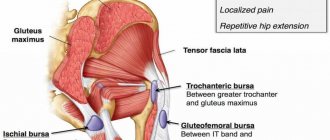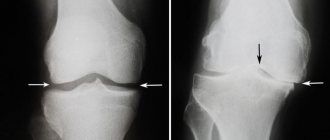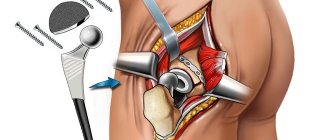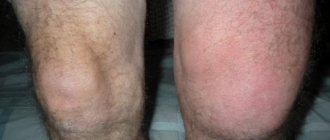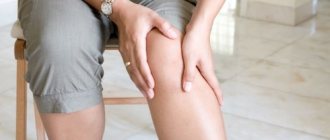0
Author of the article: Marina Dmitrievna
2018.11.26
107
Degenerative lesions-Arthrosis
Arthrosis or gonarthrosis of the 3rd degree of the knee joint is a serious disease that can lead a person to decreased motor activity and disability. The more severe the patient’s condition, the more likely it is to receive the status of a 3rd, 2nd, or even 1st degree disabled person. How is the disease classified, what should the patient do to confirm the severity of his condition, and how to avoid immobility of the lower extremities through modern surgical treatment methods?
Gonarthrosis destroys joints, making a person helpless and immobile
Factors under which disability develops
When making a decision to assign disability, the medical examination pays attention to the following factors:
- Can the patient move independently? If normal walking is impaired, grade 3 pathology is assigned, which is grounds for disability.
- Can the patient take care of himself independently? With severe limitation of joint mobility, which is typical for late stages of pathology, there is a loss of the ability to fully perform everyday activities.
- Can the patient lead a full life? If the disease progresses, performance decreases, and the person cannot perform normal activities without the help of others, the decision on disability is made individually in each specific case, depending on the general condition of the patient.
Important! The presence of at least one of the three listed points is grounds for contacting your local doctor for advice regarding the assignment of disability.
Degrees of gonarthrosis
Based on clinical manifestations, the following degrees of pathology are distinguished:
- First stage. The appearance of mild pain after physical activity on the joints, which goes away on its own without medications. Short-term swelling in the joints may occur, but the shape of the joint does not change.
- Second stage. The pain in the knees becomes more frequent and intensifies, and a crunching sensation occurs when moving. In the morning, the patient may complain of some difficulty in movement, which disappears after physical warm-up. The shape of the knees begins to change, their size increases.
- Third stage. Pain is observed almost constantly, walking becomes difficult, and lameness appears. Deformation and increase in the volume of the joint are clearly pronounced.
- Fourth stage. Clinical signs correspond to stage 3 of the disease, and it is possible to determine that the disease is progressing only by x-rays. It is noticeable on them that the joint space is completely absent.
Classification of deforming osteoarthritis according to Kosinskaya
The clinical and radiological classification according to Kosinska has been used since 1961 and is as follows:
- First stage. The joint is slightly limited in movement. X-rays show small growths of bone along the edges of the articular cavity, there are foci of ossification of the cartilage and a decrease in the joint space.
- Second stage. The mobility of the joint is limited in certain directions, and a rough crunching sound is heard. The x-ray shows significant growth of bone tissue, and the joint space is reduced by 2 times. There are signs of subchondral sclerosis.
- Third stage. The joint is deformed to a significant extent, movements are sharply limited, only rocking movements can be preserved. On X-ray, the joint space is not visible, the epiphyses are deformed and compacted, and as a result of strong bone growths, the articular surfaces are expanded.
Functional diagnostics, assessment of SDF
When a patient performs functional tests, the specialist measures the range of motion of the joint, and 4 degrees are distinguished:
- less than 50% of the norm;
- 25-40%;
- 15%;
- the joint is completely immobilized, the limb is shortened, fixed in a functionally awkward position.
To assess the SDF, the specialist relies on X-ray data and functional tests, and also pays attention to the following:
- duration and severity of pain;
- the pace of movement of the patient, the duration of the distance without a rest break, the ability to move without assistance and without devices;
- change in leg size.
The following degrees of expression are distinguished:
- Minor. The range of motion is reduced by less than 10%, compensation is normal, pain is observed only after exercise and goes away after rest.
- Moderate. The contracture is moderate. Lameness appears. After rest, the symptoms go away. The limb becomes smaller by 4 cm or more, muscle strength decreases sharply, and the thigh circumference on the affected leg decreases by 2 cm.
- Moderate, in a late stage. The contracture is clearly expressed, compensation is insufficient, pain is constantly present, the pathology progresses, the limb decreases in length by 5 cm, and the circumference of the lower leg decreases by 2 cm.
- Expressed. The contracture is severe, the decompensated stage, lameness, the circumference of the lower leg decreases by 3 cm, the thigh - by 7 cm, the limb becomes shorter by 7 cm. Muscle strength is practically absent,
- Significantly expressed. The patient's movements are limited - he can move with difficulty, and only with the help of strangers or devices.
Prevention of development
Any disease of the musculoskeletal system, including osteoarthritis of the knee joint, needs prevention. It is much easier to prevent the development of a disease than to fight it unsuccessfully for years. Therefore, to prevent gonarthrosis from developing, it is necessary:
- Lead an active and mobile lifestyle. Walk, exercise;
- Try to avoid hypothermia, as well as traumatic injury to the knee;
- Wear only comfortable shoes with low heels;
- Control your weight. Reduce the calorie content of consumed foods, limit table salt and alcohol;
- After physical activity, take proper rest;
- Carry out hardening activities and increase the body’s immune strength;
- Undergo treatment and sanitation of all foci of chronic infection;
- If the slightest signs of osteoarthritis are detected, immediately begin treatment in the amount recommended by the doctor;
Grounds for assigning a disability group
Provided that the examination revealed significant limitations in joint mobility, and if the patient is not able to care for himself at home, he is entitled to disability. Most often, group 3 is assigned, less often 2. Disability is given for a year, then it will need to be confirmed and extended. If the patient undergoes surgery (endoprosthetics) within a year, the condition of his joint will improve, which means the disability group will be reduced and completely removed. Even with very severe arthralgia there is no reason for disability. Crunching and stiffness in the joint are of purely diagnostic value.
Reference! The absolute indication for assigning disability is the presence of signs of life activity limitation.
Medication methods
Non-steroidal anti-inflammatory drugs - NSAIDs - are a group of drugs that have a general analgesic and anti-inflammatory effect. These include “Aertal”, “Celebrex”, “Movalis”, etc. For coxarthrosis, these drugs are used to eliminate inflammation of the joints and relieve severe pain. It is not recommended to use them for a long time, because... they have serious side effects and also inhibit the natural ability of articular cartilage to repair itself. If there is a need for long-term use of NSAIDs, it is recommended to use new generation drugs, the anti-pain effect of which is milder, but there are fewer contraindications and side effects.
Drugs for muscle relaxation - muscle relaxants - are a group of drugs that are used to eliminate painful muscle spasms in coxarthrosis. In addition, these medications help improve blood supply to the joint. Muscle relaxants are also not recommended for long-term use due to side effects. These include “Atracurium”, “Mydocalm”, “Norkuron”, etc.
Vasodilators (Teonikol, Actovegin, Berlition) are a group of drugs that relax the smooth muscles of blood vessels and promote their dilation. The use of these drugs for coxarthrosis leads to the relief of spasms of small vessels and the elimination of “night” vascular pain by improving vascular blood supply. The drugs have few contraindications and give good results not only in relieving pain, but also in treating coxarthrosis in general.
How to pass the examination
The first step is to collect a package of documents - examinations from medical institutions where treatment was carried out, extracts from medical records, examination results.
A rheumatologist, having studied the collected documents, can say quite accurately whether it makes sense to submit documents for a disability examination. If a patient has 1st degree of arthrosis, he will not be given disability; in case of 2nd degree, it can be assigned in exceptional cases:
- there is damage to both joints or there are disorders in joints other than the knee;
- complications with other pathologies;
- persistent violations of the SDF and movement impairment in the 1st degree.
You should apply for disability in the following cases:
- the disease has been observed for more than 3 years, and during this time there have been at least 3 exacerbations;
- presence of background pathologies;
- rapid development of the disease, decompensation;
- an operation was performed, but the condition worsened;
- disruption of normal life activities due to pathology.
Disability groups for arthrosis
Group 1 includes patients who cannot exist without the help of other people.
They cannot move, perform hygiene procedures, or eat food on their own. Group 2 includes patients whose joints are significantly deformed and movement is possible only with the help of other people or special means. Disability group 3 is assigned to those with moderate manifestations of gonarthrosis:
- restrictions in movement are minimal, a person can perform usual activities, but more slowly than a healthy person;
- a cane is used when walking;
- recovery requires a long rest.
How to register a group for gonarthrosis
To receive a disability group you must have:
- conclusion of a neurologist, orthopedist, therapist and surgeon;
- general blood and urine analysis;
- fluorography;
- electrocardiogram;
- X-ray of joints.
These documents must be provided to the expert commission.
Massage and gymnastics
An effective, useful and harmless method of relieving pain from coxarthrosis is therapeutic massage. It helps relieve painful spasms and muscle swelling by strengthening blood vessels and improving blood circulation. With regular use, it promotes the natural restoration of cartilage. You can do the massage yourself. The following massage techniques are used: stroking, rubbing, light patting on the surface of the hip joint. It is also recommended to use a professional technique of deep joint massage.
Massage for coxarthrosis is recommended to be carried out in combination with regular therapeutic exercises, which also strengthens muscles and improves blood circulation. Gymnastic exercises should be performed gently and smoothly in order to carefully work out the affected joint and not harm it. Performing voluntary, smooth movements of the pelvis in a warm bath also helps to soothe pain and relieve muscle tension.
Is endoprosthetics a basis for assigning disability?
Joint replacement is not intended to give a person a disability; the operation is aimed precisely at restoring the patient’s lost ability to work and helping to avoid the status of a disabled person. However, if the operation was unsuccessful - surgical errors, incorrect fit of the prosthesis, poor quality medical care, and so on, the patient can collect documents to apply for disability.
Why is disability given for grade 3 coxarthrosis?
Stage 3 coxarthrosis is characterized by necrotic changes in the joint, patients suffer from very severe pain. Most often, in this case, surgical intervention is recommended, but if the operation is impossible for some reason, or it was performed, but no positive result was observed, the patient has the right to apply for disability.
Getting around is becoming more difficult
3rd degree coxarthrosis is accompanied by:
- severe pain;
- weak motor activity;
- change in gait;
- reduction in the size of one lower limb;
- characteristic crunching sound when moving.
The patient cannot move without auxiliary support.
It all depends on the degree of disability
Most often, with grade 3 coxarthrosis, the patient is assigned disability group 3. In case of significant shortening of the limb size (7 cm or more), the patient is assigned to group 2. The first group of disability is assigned in the case when the patient cannot move independently and is not able to care for himself. In most cases it is given to wheelchair users.
Confirmation of disability due to coxarthrosis
Up to degree 2, pathology is not a basis for assigning disability. The main criterion is OZD. If a person can no longer walk without assistive devices or assistance from others, they need to start collecting documents for disability.
The group is given in the following cases:
- the right and left hip joints are affected - bilateral coxarthrosis of the 2nd degree;
- coxarthrosis of the 2nd degree is combined with gonarthrosis of the 2nd or 3rd degree;
- the lower limb is shortened by 7 cm or more;
- rapid progression of the disease - confirmation with a series of x-rays is necessary.
Permanence of legislation, diagnosis or group?
The legislation of the Russian Federation does not stipulate the assignment of disability for arthrosis of certain joints. And therefore, the main criterion for determining disability is a violation of the static-dynamic function of the body. A comprehensive medical and social study should not only determine the severity of the pathology, but also the consequences that this disease has led to - the inability to independently care for oneself, to move without assistance, the inability to earn a living.
Functional diagnostics
In order to identify gonarthrosis of the affected joint and begin to treat it correctly, methods are used that are conventionally divided into laboratory and instrumental.
Arthroscopy examines the joint using an LED conductor, which is inserted into the cavity opening on the side of the knee. This method allows you to see the internal structure of the affected area. The advantage of this method is its versatility (it is used not only for diagnostic, but also for therapeutic purposes). The disadvantage of this method of detecting violations is the possibility of microorganisms entering the depressurized joint cavity.
To read: Is it possible to steam and warm up in a bathhouse with radiculitis?
Using arthroscopy, you can remove chondrophytes, synovial polyps, and correct the shape of the menisci.
Computed tomography helps the specialist to recreate images of the diseased area along its entire circumference. After processing on a computer, specialists receive a three-dimensional image. Often used to examine the hip joint. The increased radiation dose is fully compensated by detailed data.
X-rays are performed in two projections to obtain images from all sides. To reliably display pathological processes, a multilateral x-ray of a healthy knee is often performed. After this, a comparison is made.
Ultrasound examination to detect grade 2 arthrosis of the hip joint or knees began to be used relatively recently. This method is completely safe for the patient’s health, so it can be used not just once, but several times. Ultrasound allows you to examine the soft tissues of the joint in more detail.
Magnetic resonance imaging detects photons of a specific wavelength that are emitted by hydrogen particles as they return to their starting point when exposed to a magnetic field. This method is harmless to humans. With its help you can clearly see soft tissues.
Thermography is based on the study of body temperature fields. Where there are malignant or inflammatory foci, the temperature is much higher. Therefore, detecting grade 3 gonarthrosis of the knee joint, for example, will not be particularly difficult.
During scintigraphy, a special substance is introduced into the body of the patient under study, which reacts to a specific type of tissue, so grade 2 or other gonarthrosis is determined immediately. During an exacerbation of pathology of the ankle joint or any other joint, laboratory diagnostics are also used (general analysis of urine, blood, biochemical blood test), because with its help it is also possible to identify the course of the inflammatory-intoxication process.
Determination of disability group for arthrosis of the lower extremities
Despite the fact that arthrosis deformans is a very common disease of the joints, the consequence of which can be limited or complete loss of capacity, not all patients are assigned a disability group.
Who is sent for a medical and social examination (MSEC) of disability?
Direction given:
- Patients with rapid progression of pathology, which is characterized by pronounced radiological signs of the disease within 3 years.
- Patients who have suffered impairments and limitations in mobility after surgery,
- Persons with severe SDF impairments.
Medical and social examination (MSE): disability and its diagnosis
Having collected all the necessary documents, you need to submit them to the medical commission. The following are three stages of obtaining disability:
- Analysis of provided documents, examination of the patient.
- Social survey.
- Assignment of disability.
Criteria for determining disability groups I, II, III
1st disability group. Complete loss of ability to learn, work, move and self-care. Patients need constant help from others.
Disability group 2. Significant restrictions in independent movement, the need for assistance from other people or special means. Labor activity is not excluded, but requires an equipped workplace. Training is possible only at home or in special educational institutions.
3 disability group. The limitation of joint function is moderate. Working actively is possible, but qualifications may be reduced. A special regime is required.

